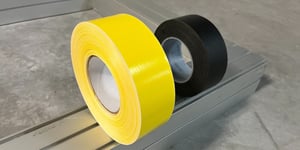Have you ever used the wrong type of adhesive?
At worst, you probably duct-taped the wall and annoyed your landlord. However, there’s no room for error when designing your product: The consequences of using the wrong adhesive could mean flushing thousands of dollars away.
Strouse has been converting adhesives for over 36 years, so while you might be anxious that you don’t know enough to make a final decision, we can provide you with the advice you need to find the right tape.
10 Different Types of Adhesives
Finding the correct tape is like stumbling through an endless, sticky maze. There’s no shame in getting lost– most people don’t think about different types of adhesive every day.
While we’re focusing on tape, film, and other flexible material options today, there are plenty of adhesive bonding materials like glue, hot melt, and epoxy to consider.
Once you’ve read through these flexible materials, you’ll better understand which adhesive you’re searching for.
1. ADHESIVE FILMS
Adhesive films are often used as a protective barrier or to bond materials with a smooth, transparent substrate to electric devices. When heat-cured in the desired position, adhesive films can adhere to two separate materials.
Adhesive films are typically processed through flatbed, rotary, or laser die cutting.
Types of adhesive film include:
- Polyester
- Polyethalene
- Polycarbonate
- Polyimide
- Polypropylene
- Polyurethane
- PTFE
2. FASTENER TAPE
Fastener tape is applicable in low-profile, double-sided adhesive bonding. The most significant advantage of fastener tape is its ability to reclose, allowing you to adhere removable parts.
Fastener tapes comprise two strips that latch onto one another via interlocking abilities, like VELCRO®. On the back of each fastener is another adhesive to join the materials. These tapes are rigid, meaning they can be cut accurately to tight tolerances.
Types of fastener tape include:
- Dual lock tape
- Industrial hook and loop tape
3. FOAM TAPE
Adhesive foam tape replaces screws or heavy fasteners and reduces the stress on a singular point of your application while making it look more aesthetically pleasing.
Foam tape can be a temporary or long-term solution, depending on the goals of your project. Die cut foam gaskets are often used for sealing or vibration dampening.
Most foam tape is either acrylic or rubber-based, with a polyester, acrylic, polyethylene, polypropylene, or urethane carrier. The foam's thickness ranges from 1 mil to 375+ mil.
Types of foam tape include:
- Acrylic
- Urethane
- Polyethylene
- Double-coated
- Vinyl
- Sponge rubber
4. FOIL ADHESIVE
Foil adhesive tapes are often made from metal and help with vibration suppression and EMI/RFI shielding.
Other features of foil adhesives are thermal management, flame resistance, efficient heating or cooling, puncture resistance, humidity bonding, and more.
Types of foil adhesive include:
- Aluminum foil tape
- Copper foil tape
- Stainless steel tape
5. INDUSTRIAL PACKING TAPE
Industrial packing tape seals packages to guarantee your customers’ goods arrive intact and untampered with. Additional uses include bag sealing, carton sealing, gummed tape, and label protection.
If you’ve ever struggled to seal a box, you already know the amount of packing tape you use might vary. However, with each material sized to custom measurements and the length of tape sized on each roll, you don’t have to guess the exact amount used per package. Adhesive tape converters will help you format specific lengths.
6. PAPER & MASKING TAPE
Paper tape is a broad category covering masking tapes, kraft paper tapes, and double-coated tapes. Industrial processes apply paper tape for paint masking, paint stripping, electroplating masking, anodizing masking, and more.
There is a wide range of custom masking tapes from different brands and types for various purposes, such as Kraft paper tape and double-sided paper tape.
7. MEDICAL TAPE
It’s essential medical tape reaches a certain standard to ensure it’s clean and safe to use straight out of the package/off the roll.
For instance, Strouse is backed by ISO-13485 and an ISO 7 cleanroom with hospital-grade air, FDA registration, and NIOSH approval. If you want a clean product, you won’t be disappointed here.
Medical tape can be hypoallergenic, latex-free, conformable for joints, and water-resistant to adhere to damp or dry skin.
Types of medical tape include:
- Medical adhesive
- Double-sided
- Hydrocolloid
- Non-woven
8. OPTICALLY CLEAR ADHESIVE
Optically clear adhesives are used on display devices like phone or TV screens and touch panels to bind the sensor unit to the cover or lens.
You may be asking yourself how it works. Still, the science is what you’d expect: optically clear adhesives are transparent, allowing them to bond to the surface of a device without distorting the graphics display.
Most screens have custom formatting to fit new device designs. Choosing an adhesive depends on finding the proper optically clear material and manufacturing environment.
9. THERMAL INTERFACE MATERIALS
Thermal interface materials are made when conductive ceramic particles are added to a high-performance acrylic adhesive for more reliable electronic device performance.
Using thermal interface materials can increase your electrical device performance by achieving better heat sink bonding and power transistor attachment.
10. TRANSFER TAPE
Transfer tapes consist of adhesive with a removable liner and no backing and are generally one of the fastest and easiest solutions to increase production efficiency. Technically, a lot of the above categories could be transfer tapes as well. We listed this one out specifically because transfer tapes tend to be harder to convert due to their thin, flexible nature.
Different transfer tapes are single or double-linered, fiber-reinforced, have permanent bonding, repositionable bonding, humidity resistant, and/or have an extended liner. In some cases, they’re used in thin bonding adhesive transfer gaskets.
Types of transfer tape include:
- Fiber reinforced
- Permanent/Repositionable
- Single/Double/Extended liner
- Humidity resistant liner
Choosing the Right Adhesive
You’ve read about each of the different adhesives, and now it’s time to decide which one best suits your product. Choosing the right adhesive boils down to your project's nature.
Consider the following questions:
- What type of surface are you using the adhesive on?
- How flexible does it need to be?
- Does your part need to last for a long time?
- Is heat involved in the use of this product?
- Is the shape of the part complex?
Answering these questions will help you narrow down your choices based on your project’s functional needs.
If you have the design for a part and you’re still looking to test out different adhesive options or materials, you can always try out different combinations through Strouse’s Sample Express.
Lastly, if you have an idea for a part but don’t know where to begin, contact us, and we’ll help you figure out what materials suit your part based on its intended purpose.
Originally published: January 4th, 2023







